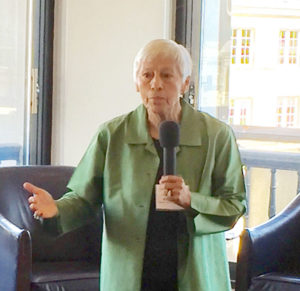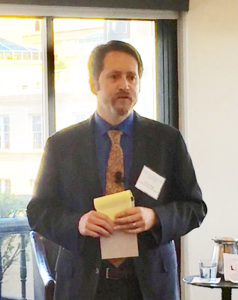To counter bullying and incivility, experts share approaches that boost empathy
By Natalie LovenburgJune 8, 2017

With reports of bullying in the headlines and increasingly diverse classrooms and communities, the need to teach students empathy and tolerance is as critical as ever, said education experts at an event at the National Press Club in Washington, D.C. on June 6.
At the “Promoting Tolerance and Civility in our Schools and Communities” event, speakers drew from personal experiences and case studies across the globe from the United States to Tunisia to analyze and share lessons learned to tackle exclusion and intolerance in multicultural settings.
Opening the dialogue, Creative Associates International’s Chair of the Board of Directors and Founder, Charito Kruvant, emphasized the need for bringing together a community of practice to share knowledge of successful interventions, identify and analyze trends, and learn from each other to strengthen a culture of civility.
“I want this to be the start of a bigger conversation that leads to results,” she said.
Throughout the event, participant tackled tough challenges around issues of bullying and civility—examining evidence around the forms of exclusion and discrimination that impede the teaching of tolerance; exploring initiatives that are having success in building civility and how to scale them; and tapping into existing leadership models that educators and community leaders can implement.
The event was sponsored by Creative, in partnership with Dr. Anthony Jackson, Vice President of Education, Asia Society, and Fernando Reimers, Ph.D., Director of Global Education Initiative, Harvard Graduate School of Education.
To read the Executive Report “Promoting Civility and Tolerance in Our Schools and Communities,” click here.
Getting at the roots of intolerance and isolation
Practicing social emotional intelligence in the classroom can play an essential role in mitigating bullying, building social skills and establishing an equitable, safe learning space, said academic and technical education experts.
During a Q&A with Dena Simmons, Ed.D., Director of Education at the Yale Center for Emotional Intelligence, she emphasized the importance of creating an inclusive learning environment.
“We must create an environment in the classroom where students can be their authentic selves,” said Simmons, whose center conducts research on applying emotional intelligence to address complex social problems that disrupt education.
“As educators, the first thing we must do is to look into the mirror and have critical self-awareness. There are continuous opportunities for us to learn about diversity of experiences and have mutual education by asking our students questions.”
“What does tolerance and inclusion look and feel like? What does it actually mean in practice?” she asked the audience during the Q&A session called “Addressing the Root Causes of Intolerance.”
Simmons pulled from her own life experience in the work she does. The daughter of a mother from the island of Antigua, she grew up in the Bronx in New York City. Her family valued education and eventually enrolled her in boarding school in Connecticut. Simmons forged her way through a challenging and often unaccepting learning environment.
“I felt that I had to erase myself to be welcomed,” she explained. “Being black, an immigrant and a woman needed to fit into a box—a box that was not created for me.”
Previously a middle school teacher in the Bronx, Simmons drew on her own boarding school experience of feeling isolated at times to help ensure her students saw themselves reflected in what they were learning and did not feel invisible.
Experiencing intolerance and discrimination at school and in a community can result in psychological trauma that can negatively affect the mental health of children and youth and their ability to grow and learn, she added.
Simmons shared some practical suggestions that can empower teachers to encourage students to practice empathy and mindfulness.
“As educators, the first thing we must do is to look into the mirror and have critical self-awareness,” she said. “There are continuous opportunities for us to learn about diversity of experiences and have mutual education by asking our students questions.”
She advised that by asking students simple yet engaging questions like, “What do you need to help manage or express your emotions? What do you like? What do you not like?” teachers can set a positive and trusting tone and cultivate social emotional intelligence in the classroom.
Along with Social Emotional Learning and empathy, it’s important to shift away from single narratives and putting people in a box, she explained.
“I hope we can all walk into a room, look around and see each other’s humanity,” she said.
Initiatives that reduce school violence and hate crime

In a session called “Building Resiliency in Schools and Communities,” experts in education and violence prevention explained how preventative risk reduction measures can improve the resilience of learning environments and reach young people at-risk for violence before bullying escalates.
“Youth violence often starts at schools, in families and in communities,” explained Enrique Roig, Director of Citizen Security, Creative, which applies a public health model to reach at-risk youth who are more susceptible to engaging in gang activity and violent extremists groups and help lower their risk factors for violence.
Factors such as lack of parental supervision, drug use and impulsive risk taking are among the risk factors evaluated that contribute to youth joining these groups.
In May, Creative’s experts shared this public health model and a tool to empirically identify different levels of risk, at the Los Angeles Gang Prevention and Intervention Conference in California and the Strong Cities Global Network Summit in Denmark.
After the risk assessment, Creative’s programs then work through family counselors to establish positive relationships and behaviors in a family that help lower the youth’s risk factors for violence.
“In the work we’re doing at Creative, we aim to identify better ways to understand why a young, at-risk person usually between the ages of 10 and 15 decides to cross that threshold and commit acts of violence,” Roig explained.
While these individualized interventions help reach those youth most at risk of committing violence, other classroom-based initiatives have shown success in building empathy that can reduce bullying, harassment and crime, even at an early age.
David Esquith, Director of the Office of Safe and Healthy Students at the U.S. Education Department, presented the “Framework for Developing Global and Cultural Competencies to Advance Equity, Excellence and Economic Competitiveness.” The framework includes guidance for educators across the spectrum from early childhood through post-secondary education.
“We are a seeing positive impact on hateful crimes and harassment from schools using positive behavior interventions and support, Social Emotional Learning and getting kids in touch with their behaviors and feelings.”
“We have learned that if we address Social Emotional Learning and increase kids’ ability to empathize, we can see a decrease in hateful, violent behavior that is traumatic,” said Esquith, adding that as of 2015 reports of witnessing hate crimes in schools have decreased.
“We are a seeing positive impact on hateful crimes and harassment from schools using positive behavior interventions and support, Social Emotional Learning and getting kids in touch with their behaviors and feelings,” he said
Despite the progress Esquith and others referred to, news reports of bullying, hate speech and violence in educational contexts and online spaces continue, making the push for teaching empathy and tolerance ever more critical.
There is a great need for further collaboration among educators and experts to conduct additional research and refine approaches and interventions to promote tolerance and civility in the classroom, said Fernando Reimers, Ph.D., in concluding remarks.
“We learn from each other,” he said. “Gathering together has heightened our awareness in building understanding on what best practices are available, identifying gaps and seeing how we can effectively collaborate together to make a positive impact in our schools.”

